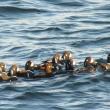Harlequin Habits on the Maine Coast
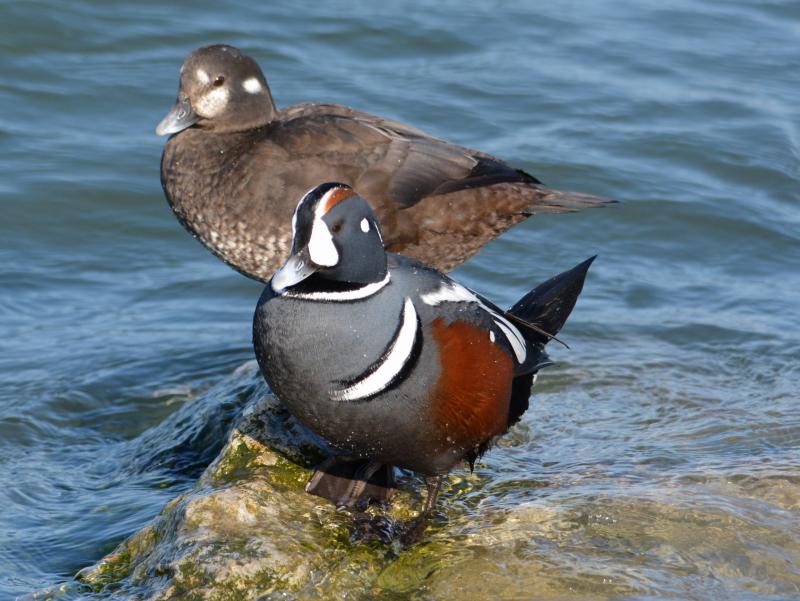 Maine's coast supports a large proportion of the wintering population of the eastern North American population of harlequin duck although the largest numbers are in remote parts of the coast like the area around Isle Au Haut off the Blue Hill Peninsula. Peggy Cadigan photo courtesy of Wikimedia Commons
Maine's coast supports a large proportion of the wintering population of the eastern North American population of harlequin duck although the largest numbers are in remote parts of the coast like the area around Isle Au Haut off the Blue Hill Peninsula. Peggy Cadigan photo courtesy of Wikimedia Commons
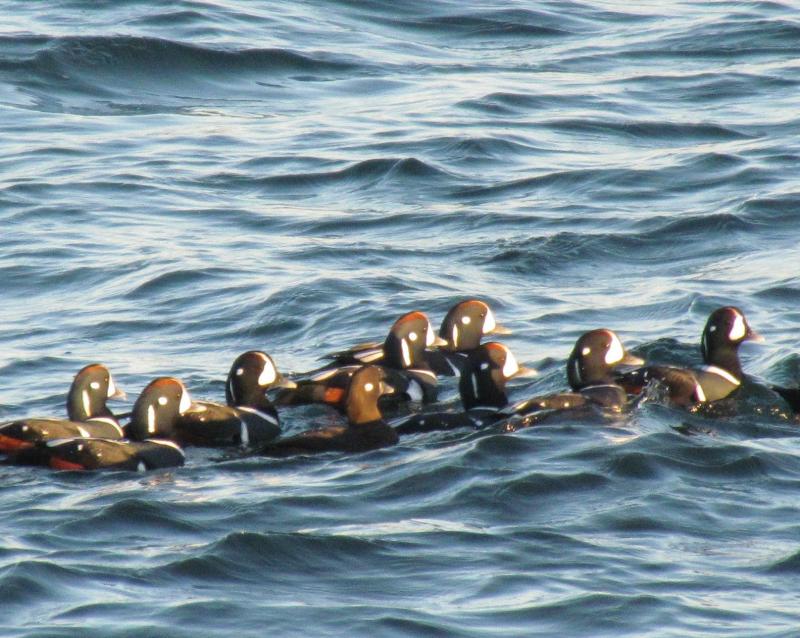 Harlequin ducks in eastern North America nest along rocky streams in Quebec, Newfoundland and Labrador, and western Greenland and move south in winter to the Maine coast (like these here at Two Lights State Park in Cape Elizabeth, Maine) with smaller numbers south to Maryland. Courtesy of Jeff and Allison Wells
Harlequin ducks in eastern North America nest along rocky streams in Quebec, Newfoundland and Labrador, and western Greenland and move south in winter to the Maine coast (like these here at Two Lights State Park in Cape Elizabeth, Maine) with smaller numbers south to Maryland. Courtesy of Jeff and Allison Wells
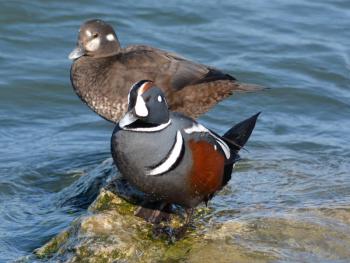 Maine's coast supports a large proportion of the wintering population of the eastern North American population of harlequin duck although the largest numbers are in remote parts of the coast like the area around Isle Au Haut off the Blue Hill Peninsula. Peggy Cadigan photo courtesy of Wikimedia Commons
Maine's coast supports a large proportion of the wintering population of the eastern North American population of harlequin duck although the largest numbers are in remote parts of the coast like the area around Isle Au Haut off the Blue Hill Peninsula. Peggy Cadigan photo courtesy of Wikimedia Commons
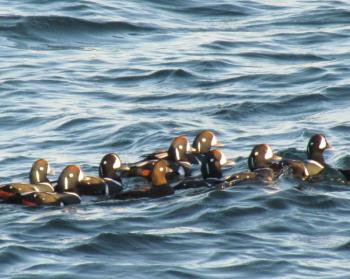 Harlequin ducks in eastern North America nest along rocky streams in Quebec, Newfoundland and Labrador, and western Greenland and move south in winter to the Maine coast (like these here at Two Lights State Park in Cape Elizabeth, Maine) with smaller numbers south to Maryland. Courtesy of Jeff and Allison Wells
Harlequin ducks in eastern North America nest along rocky streams in Quebec, Newfoundland and Labrador, and western Greenland and move south in winter to the Maine coast (like these here at Two Lights State Park in Cape Elizabeth, Maine) with smaller numbers south to Maryland. Courtesy of Jeff and Allison Wells
This column arrived too late for print in the Jan. 2 issue.
It all started with a discussion of harlequin ducks.
With a few days off at the holidays, we were thinking about places we might consider for a birding foray. Being perhaps the most elegantly plumaged duck to occur in Maine and also a species that only visits the state in the winter months, our thoughts went to places where we had a good chance of seeing harlequin ducks.
Perhaps the best known and most accessed location to view them is Marginal Way in Ogunquit or the close-by Bald Head Cliff in York. We’ve soaked in stunning views of these little ducks, the males with their slate-blue bodies marked with white dots and lines (as if created by an abstract painter) set off by deep cinnamon red on the flanks and a cinnamon red streak curving across the edge of the crown.
By way of regular wintering areas for harlequin ducks, there’s the slightly closer (to us) Two Lights State Park in Cape Elizabeth and nearby Dyer Point. The largest wintering concentration of the species in Maine is around the southern half of the island of Isle Au Haut. But that’s not a place anyone would describe as readily accessible to the average birder, even less so in winter. For several years back in the late 1970s and 1980s, the Penobscot Valley Audubon Society from the Bangor-Orono area would charter a boat from Stonington in late winter to circumnavigate the island just to see how many harlequins were there. Those trips were legendary!
Harlequin ducks are famous for wintering along cold, wave-tossed rocky shores. Like other sea ducks that live in such places, they dive for crabs, mussels, snails, small fish, and other prey items. They have a remarkable ability to time their dives safely among waves that would crush and tumble a human.
So, if the main habitat requirement for harlequin ducks is rocky, wave-tossed shores, why aren’t they seen daily at places like Pemaquid Point, Reid State Park, Bailey Island, Owls Head, and other locales that seem to have similar habitat? Harlequin ducks are occasionally seen at lots of places along the coast, including all the places we just mentioned, but they are not regular. A few birds may linger for a period but then none may be seen for years—the birds are certainly not seen there every day as they are at places like Ogunquit’s Marginal Way or Two Lights State Park.
Maybe it really is because certain places have preferred habitat characteristics that are not obvious to us and have food sources that are more abundant or easily accessed.
That’s certainly the explanation that most of us tend to assume with birds and other animals—that they go to places that have the habitats in which they have evolved to be most successful. You don’t find robins swimming in a lake and you don’t find loons looking for worms on a lawn! But, do you find a loon on every lake or a robin on every lawn? Is it only the quality of the habitat and the food sources that determine where they go?
We started wondering how much the current location of popular wintering places for harlequin ducks could have been influenced by history, even a type of cultural history. If harlequin duck populations were low in the past and began to rebound, would birds that returned have brought their descendants back to the places that they have found and successfully wintered? As long as numbers didn’t get too high, would this result in birds returning to these same places even if there were other equally good places? If harlequin duck numbers increase enough, might we expect that we will see more flocks starting to regularly stay in other places along the coast like they do at Two Lights, Marginal Way, and Cliff House?
It’s probably even more complicated than all that, but doesn’t it make you want to get out and see a harlequin duck bobbing in the foam near a granite ledge on a classic Maine blue-sky winter day?
Jeffrey V. Wells, Ph.D., is a Fellow of the Cornell Lab of Ornithology and Vice President of Boreal Conservation for National Audubon. Dr. Wells is one of the nation's leading bird experts and conservation biologists. He is a coauthor of the seminal “Birds of Maine” book and author of the “Birder’s Conservation Handbook.” His grandfather, the late John Chase, was a columnist for the Boothbay Register for many years. Allison Childs Wells, formerly of the Cornell Lab of Ornithology, is a senior director at the Natural Resources Council of Maine, a nonprofit membership organization working statewide to protect the nature of Maine. Both are widely published natural history writers and are the authors of the popular books, “Maine’s Favorite Birds” (Tilbury House) and “Birds of Aruba, Bonaire, and Curaçao: A Site and Field Guide,” (Cornell University Press).




